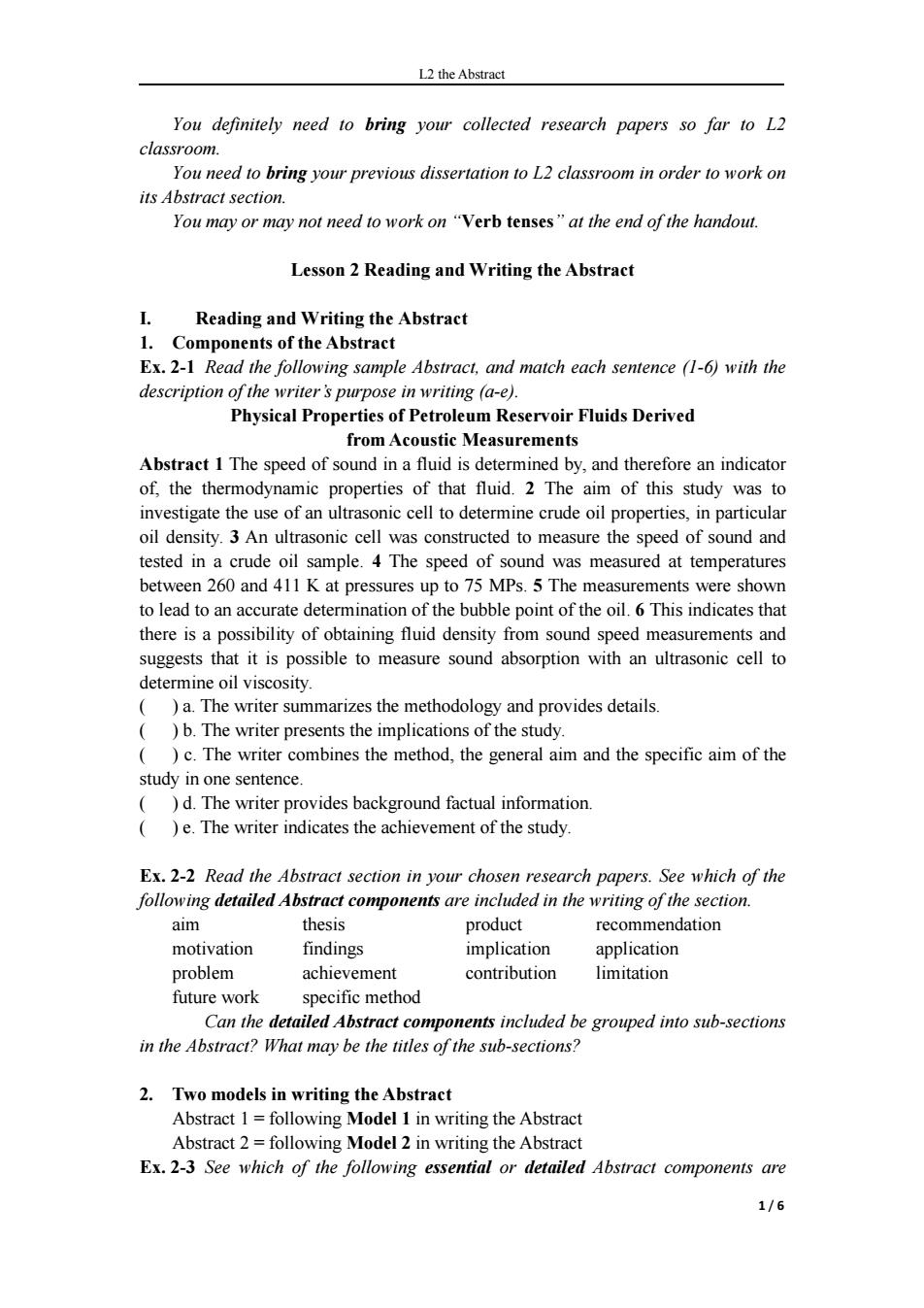
L2 the Abstract You definitely need to bring your collected research papers so far to L2 classroom You need to bring your previous dissertation to L2 classroom in order to work on its Abstract section. You may or may not need to work on "Verb tenses"at the end of the handout. Lesson 2 Reading and Writing the Abstract Reading and Writing the Abstract 1.Components of the Abstract Ex.2-1 Read the following sample Abstract,and match each sentence (1-6)with the description of the writer's purpose in writing (a-e). Physical Properties of Petroleum Reservoir Fluids Derived from Acoustic Measurements Abstract 1 The speed of sound in a fluid is determined by,and therefore an indicator of,the thermodynamic properties of that fluid.2 The aim of this study was to investigate the use of an ultrasonic cell to determine crude oil properties,in particular oil density.3 An ultrasonic cell was constructed to measure the speed of sound and tested in a crude oil sample.4 The speed of sound was measured at temperatures between 260 and 411 K at pressures up to 75 MPs.5 The measurements were shown to lead to an accurate determination of the bubble point of the oil.6 This indicates that there is a possibility of obtaining fluid density from sound speed measurements and suggests that it is possible to measure sound absorption with an ultrasonic cell to determine oil viscosity. ()a.The writer summarizes the methodology and provides details ()b.The writer presents the implications of the study. ()c.The writer combines the method,the general aim and the specific aim of the study in one sentence. ()d.The writer provides background factual information. ()e.The writer indicates the achievement of the study. Ex.2-2 Read the Abstract section in your chosen research papers.See which of the following detailed Abstract components are included in the writing of the section. aim thesis product recommendation motivation findings implication application problem achievement contribution limitation future work specific method Can the detailed Abstract components included be grouped into sub-sections in the Abstract?What may be the titles of the sub-sections? 2.Two models in writing the Abstract Abstract 1 following Model 1 in writing the Abstract Abstract 2=following Model 2 in writing the Abstract Ex.2-3 See which of the following essential or detailed Abstract components are 1/6
L2 the Abstract 1 / 6 You definitely need to bring your collected research papers so far to L2 classroom. You need to bring your previous dissertation to L2 classroom in order to work on its Abstract section. You may or may not need to work on “Verb tenses” at the end of the handout. Lesson 2 Reading and Writing the Abstract I. Reading and Writing the Abstract 1. Components of the Abstract Ex. 2-1 Read the following sample Abstract, and match each sentence (1-6) with the description of the writer’s purpose in writing (a-e). Physical Properties of Petroleum Reservoir Fluids Derived from Acoustic Measurements Abstract 1 The speed of sound in a fluid is determined by, and therefore an indicator of, the thermodynamic properties of that fluid. 2 The aim of this study was to investigate the use of an ultrasonic cell to determine crude oil properties, in particular oil density. 3 An ultrasonic cell was constructed to measure the speed of sound and tested in a crude oil sample. 4 The speed of sound was measured at temperatures between 260 and 411 K at pressures up to 75 MPs. 5 The measurements were shown to lead to an accurate determination of the bubble point of the oil. 6 This indicates that there is a possibility of obtaining fluid density from sound speed measurements and suggests that it is possible to measure sound absorption with an ultrasonic cell to determine oil viscosity. ( ) a. The writer summarizes the methodology and provides details. ( ) b. The writer presents the implications of the study. ( ) c. The writer combines the method, the general aim and the specific aim of the study in one sentence. ( ) d. The writer provides background factual information. ( ) e. The writer indicates the achievement of the study. Ex. 2-2 Read the Abstract section in your chosen research papers. See which of the following detailed Abstract components are included in the writing of the section. aim thesis product recommendation motivation findings implication application problem achievement contribution limitation future work specific method Can the detailed Abstract components included be grouped into sub-sections in the Abstract? What may be the titles of the sub-sections? 2. Two models in writing the Abstract Abstract 1 = following Model 1 in writing the Abstract Abstract 2 = following Model 2 in writing the Abstract Ex. 2-3 See which of the following essential or detailed Abstract components are
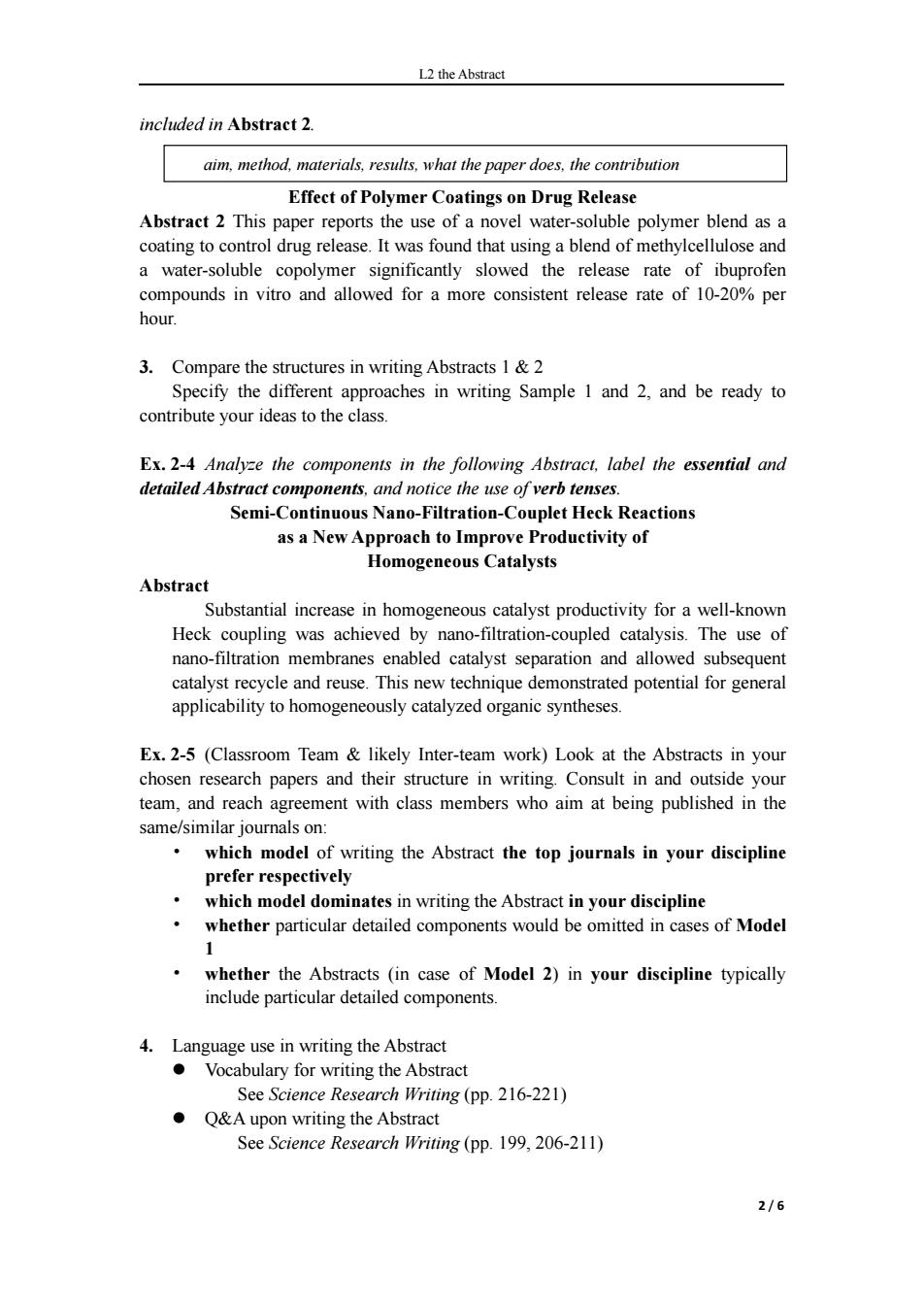
L2 the Abstract included in Abstract 2. aim,method,materials,results,what the paper does,the contribution Effect of Polymer Coatings on Drug Release Abstract 2 This paper reports the use of a novel water-soluble polymer blend as a coating to control drug release.It was found that using a blend of methylcellulose and a water-soluble copolymer significantly slowed the release rate of ibuprofen compounds in vitro and allowed for a more consistent release rate of 10-20%per hour. 3.Compare the structures in writing Abstracts 1 &2 Specify the different approaches in writing Sample 1 and 2,and be ready to contribute your ideas to the class. Ex.2-4 Analyze the components in the following Abstract,label the essential and detailed Abstract components,and notice the use of verb tenses. Semi-Continuous Nano-Filtration-Couplet Heck Reactions as a New Approach to Improve Productivity of Homogeneous Catalysts Abstract Substantial increase in homogeneous catalyst productivity for a well-known Heck coupling was achieved by nano-filtration-coupled catalysis.The use of nano-filtration membranes enabled catalyst separation and allowed subsequent catalyst recycle and reuse.This new technique demonstrated potential for general applicability to homogeneously catalyzed organic syntheses. Ex.2-5 (Classroom Team likely Inter-team work)Look at the Abstracts in your chosen research papers and their structure in writing.Consult in and outside your team,and reach agreement with class members who aim at being published in the same/similar journals on: which model of writing the Abstract the top journals in your discipline prefer respectively which model dominates in writing the Abstract in your discipline whether particular detailed components would be omitted in cases of Model 1 whether the Abstracts (in case of Model 2)in your discipline typically include particular detailed components. 4.Language use in writing the Abstract Vocabulary for writing the Abstract See Science Research Writing (pp.216-221) Q&A upon writing the Abstract See Science Research Writing (pp.199,206-211) 2/6
L2 the Abstract 2 / 6 included in Abstract 2. Effect of Polymer Coatings on Drug Release Abstract 2 This paper reports the use of a novel water-soluble polymer blend as a coating to control drug release. It was found that using a blend of methylcellulose and a water-soluble copolymer significantly slowed the release rate of ibuprofen compounds in vitro and allowed for a more consistent release rate of 10-20% per hour. 3. Compare the structures in writing Abstracts 1 & 2 Specify the different approaches in writing Sample 1 and 2, and be ready to contribute your ideas to the class. Ex. 2-4 Analyze the components in the following Abstract, label the essential and detailed Abstract components, and notice the use of verb tenses. Semi-Continuous Nano-Filtration-Couplet Heck Reactions as a New Approach to Improve Productivity of Homogeneous Catalysts Abstract Substantial increase in homogeneous catalyst productivity for a well-known Heck coupling was achieved by nano-filtration-coupled catalysis. The use of nano-filtration membranes enabled catalyst separation and allowed subsequent catalyst recycle and reuse. This new technique demonstrated potential for general applicability to homogeneously catalyzed organic syntheses. Ex. 2-5 (Classroom Team & likely Inter-team work) Look at the Abstracts in your chosen research papers and their structure in writing. Consult in and outside your team, and reach agreement with class members who aim at being published in the same/similar journals on: • which model of writing the Abstract the top journals in your discipline prefer respectively • which model dominates in writing the Abstract in your discipline • whether particular detailed components would be omitted in cases of Model 1 • whether the Abstracts (in case of Model 2) in your discipline typically include particular detailed components. 4. Language use in writing the Abstract Vocabulary for writing the Abstract See Science Research Writing (pp. 216-221) Q&A upon writing the Abstract See Science Research Writing (pp. 199, 206-211) aim, method, materials, results, what the paper does, the contribution
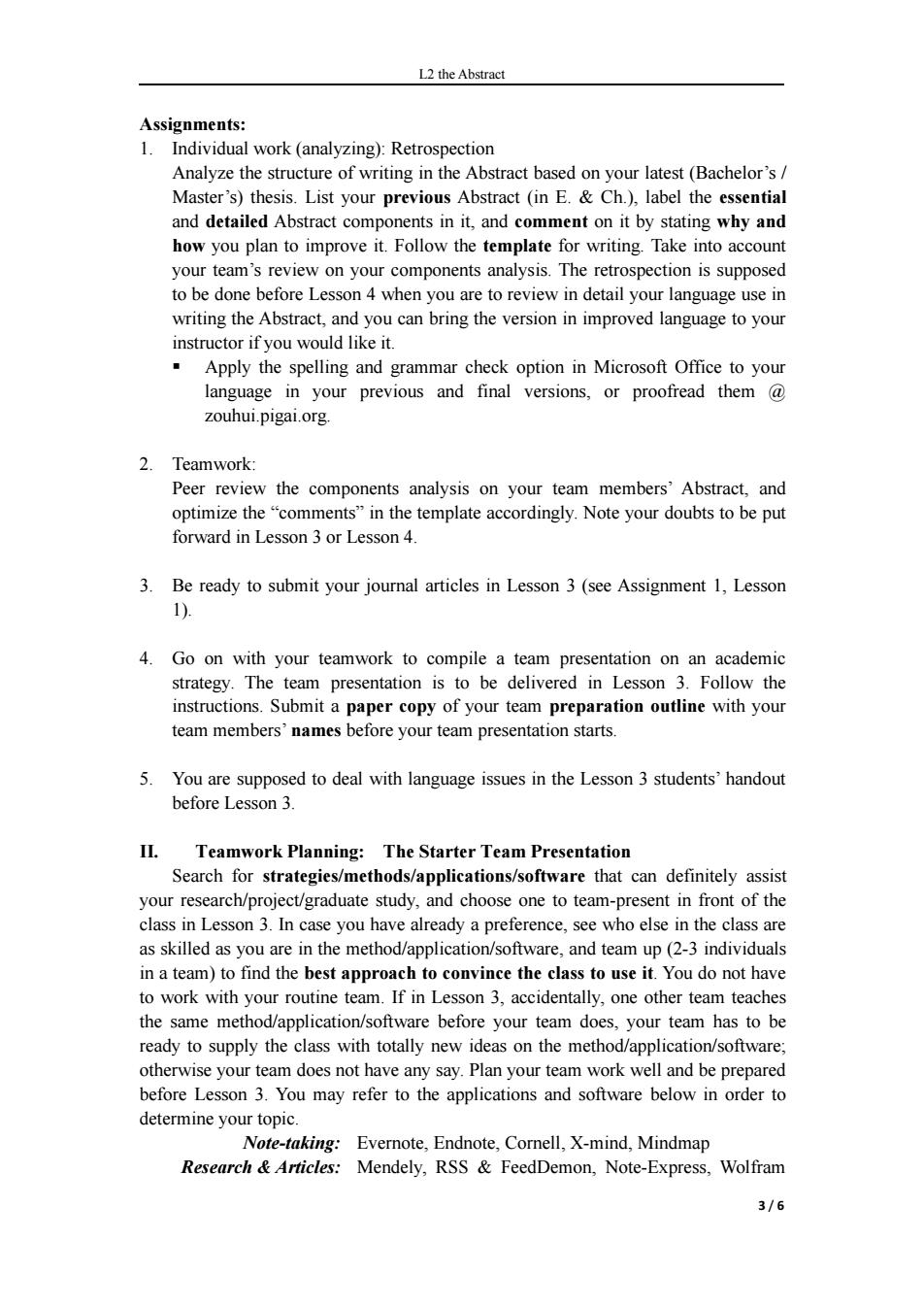
L2 the Abstract Assignments: 1.Individual work(analyzing):Retrospection Analyze the structure of writing in the Abstract based on your latest(Bachelor's Master's)thesis.List your previous Abstract (in E.Ch.),label the essential and detailed Abstract components in it,and comment on it by stating why and how you plan to improve it.Follow the template for writing.Take into account your team's review on your components analysis.The retrospection is supposed to be done before Lesson 4 when you are to review in detail your language use in writing the Abstract,and you can bring the version in improved language to your instructor if you would like it. ■ Apply the spelling and grammar check option in Microsoft Office to your language in your previous and final versions,or proofread them zouhui.pigai.org. 2. Teamwork: Peer review the components analysis on your team members'Abstract,and optimize the"comments"in the template accordingly.Note your doubts to be put forward in Lesson 3 or Lesson 4. 3.Be ready to submit your journal articles in Lesson 3(see Assignment 1,Lesson 1). 4.Go on with your teamwork to compile a team presentation on an academic strategy.The team presentation is to be delivered in Lesson 3.Follow the instructions.Submit a paper copy of your team preparation outline with your team members'names before your team presentation starts. 5. You are supposed to deal with language issues in the Lesson 3 students'handout before Lesson 3. II.Teamwork Planning:The Starter Team Presentation Search for strategies/methods/applications/software that can definitely assist your research/project/graduate study,and choose one to team-present in front of the class in Lesson 3.In case you have already a preference,see who else in the class are as skilled as you are in the method/application/software,and team up(2-3 individuals in a team)to find the best approach to convince the class to use it.You do not have to work with your routine team.If in Lesson 3,accidentally,one other team teaches the same method/application/software before your team does,your team has to be ready to supply the class with totally new ideas on the method/application/software; otherwise your team does not have any say.Plan your team work well and be prepared before Lesson 3.You may refer to the applications and software below in order to determine your topic. Note-taking:Evernote,Endnote,Cornell,X-mind,Mindmap Research Articles:Mendely,RSS FeedDemon,Note-Express,Wolfram 3/6
L2 the Abstract 3 / 6 Assignments: 1. Individual work (analyzing): Retrospection Analyze the structure of writing in the Abstract based on your latest (Bachelor’s / Master’s) thesis. List your previous Abstract (in E. & Ch.), label the essential and detailed Abstract components in it, and comment on it by stating why and how you plan to improve it. Follow the template for writing. Take into account your team’s review on your components analysis. The retrospection is supposed to be done before Lesson 4 when you are to review in detail your language use in writing the Abstract, and you can bring the version in improved language to your instructor if you would like it. Apply the spelling and grammar check option in Microsoft Office to your language in your previous and final versions, or proofread them @ zouhui.pigai.org. 2. Teamwork: Peer review the components analysis on your team members’ Abstract, and optimize the “comments” in the template accordingly. Note your doubts to be put forward in Lesson 3 or Lesson 4. 3. Be ready to submit your journal articles in Lesson 3 (see Assignment 1, Lesson 1). 4. Go on with your teamwork to compile a team presentation on an academic strategy. The team presentation is to be delivered in Lesson 3. Follow the instructions. Submit a paper copy of your team preparation outline with your team members’ names before your team presentation starts. 5. You are supposed to deal with language issues in the Lesson 3 students’ handout before Lesson 3. II. Teamwork Planning: The Starter Team Presentation Search for strategies/methods/applications/software that can definitely assist your research/project/graduate study, and choose one to team-present in front of the class in Lesson 3. In case you have already a preference, see who else in the class are as skilled as you are in the method/application/software, and team up (2-3 individuals in a team) to find the best approach to convince the class to use it. You do not have to work with your routine team. If in Lesson 3, accidentally, one other team teaches the same method/application/software before your team does, your team has to be ready to supply the class with totally new ideas on the method/application/software; otherwise your team does not have any say. Plan your team work well and be prepared before Lesson 3. You may refer to the applications and software below in order to determine your topic. Note-taking: Evernote, Endnote, Cornell, X-mind, Mindmap Research & Articles: Mendely, RSS & FeedDemon, Note-Express, Wolfram

L2 the Abstract Alpha,Kindle,SciFinder,Zotero,muchong.com,Latex, REFPROP Data processing:GETDATA,Ggplot2,Autodesk ForceEffect,Plotly Language:Eudic Time Management: Pomotodo.Doit.im The time limit is 2 minutes per individual.Be specific and concise.You will be stopped when your time is up. The start-of-the-semester team presentation is supposed to help you determine your goals in improving your(academic/general)presentation skills in the semester. Think about what you may do to help you determine your goals. The final team presentation is to be graded with the following grading rubric. You may need to refer as well to the same rubric when you work on your starter team presentation. Grading the Presentation (Total=15) Choosing the Topic 3 Related to your academic purposes Appropriate for the time limit Arousing interest from and understandable for your audience Structure 3 Complete in structure Signposts and transitions to guide the audience Slides 1 Simple,direct,and clear Used to assist you,not to replace you Delivery 4 Well-modulated voice (individually Appropriate body language (eye contact,facial graded) expressions,gestures,and stance) Language The academic speaking style of presentation (individually Appropriate vocabulary and sentence patterns for graded) effective communication Before your team presentation: Submit your Team Preparation Outline (paper copy)(See Sample Preparation Outline.docx); ● Rehearse and time yourself to meet the time limit; The grading rubric above may be used by particular members of audience you appoint to give you feedback on your presentation performance; Arrange to seek feedback from particular audience on your performance. Before other teams'presentation,be ready to: ●take notes, grade the speakers and evaluate their presentation performance. 4/6
L2 the Abstract 4 / 6 Alpha, Kindle, SciFinder, Zotero, muchong.com, Latex, REFPROP Data processing: GETDATA, Ggplot2, Autodesk ForceEffect, Plotly Language: Eudic Time Management: Pomotodo, Doit.im The time limit is 2 minutes per individual. Be specific and concise. You will be stopped when your time is up. The start-of-the-semester team presentation is supposed to help you determine your goals in improving your (academic / general) presentation skills in the semester. Think about what you may do to help you determine your goals. The final team presentation is to be graded with the following grading rubric. You may need to refer as well to the same rubric when you work on your starter team presentation. Grading the Presentation (Total = 15) Choosing the Topic 3 Related to your academic purposes Appropriate for the time limit Arousing interest from and understandable for your audience Structure 3 Complete in structure Signposts and transitions to guide the audience Slides 1 Simple, direct, and clear Used to assist you, not to replace you Delivery (individually graded) 4 Well-modulated voice Appropriate body language (eye contact, facial expressions, gestures, and stance) Language (individually graded) 4 The academic speaking style of presentation Appropriate vocabulary and sentence patterns for effective communication Before your team presentation: Submit your Team Preparation Outline (paper copy) (See Sample Preparation Outline.docx); Rehearse and time yourself to meet the time limit; The grading rubric above may be used by particular members of audience you appoint to give you feedback on your presentation performance; Arrange to seek feedback from particular audience on your performance. Before other teams’ presentation, be ready to: take notes; grade the speakers and evaluate their presentation performance
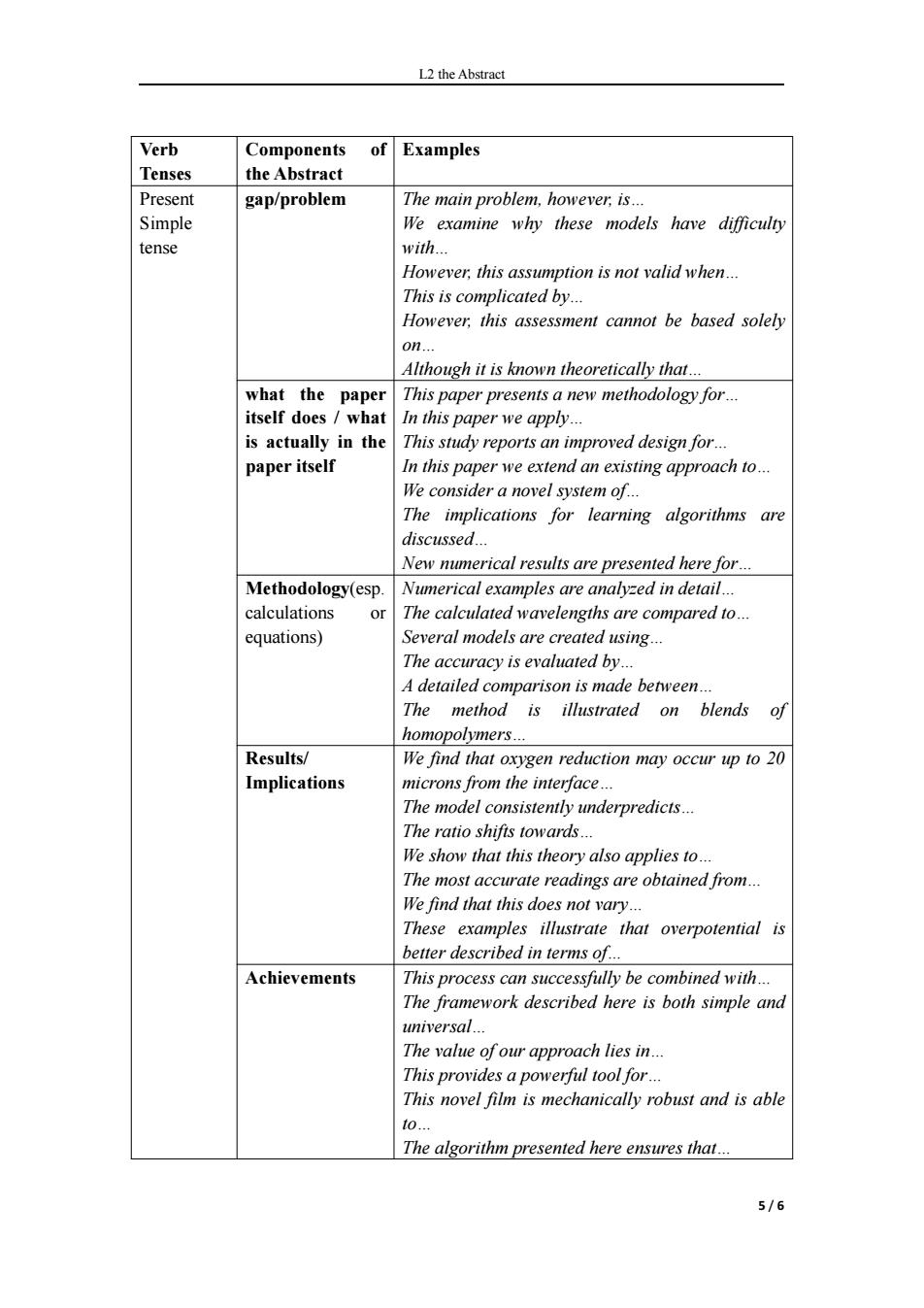
L2 the Abstract Verb Components of Examples Tenses the Abstract Present gap/problem The main problem,however;is.. Simple We examine why these models have difficulty tense with... However;this assumption is not valid when... This is complicated by... However,this assessment cannot be based solely 0n.. Although it is known theoretically that. what the paper This paper presents a new methodology for... itself does /what In this paper we apply... is actually in the This study reports an improved design for... paper itself In this paper we extend an existing approach to... We consider a novel system of... The implications for learning algorithms are discussed... New numerical results are presented here for... Methodology(esp. Numerical examples are analyzed in detail... calculations or The calculated wavelengths are compared to... equations) Several models are created using... The accuracy is evaluated by... A detailed comparison is made between... The method is illustrated on blends of homopolymers... Results/ We find that oxygen reduction may occur up to 20 Implications microns from the interface... The model consistently underpredicts... The ratio shifts towards... We show that this theory also applies to... The most accurate readings are obtained from... We find that this does not vary... These examples illustrate that overpotential is better described in terms of... Achievements This process can successfully be combined with... The framework described here is both simple and universal... The value of our approach lies in... This provides a powerful tool for... This novel film is mechanically robust and is able t0.… The algorithm presented here ensures that. 5/6
L2 the Abstract 5 / 6 Verb Tenses Components of the Abstract Examples Present Simple tense gap/problem The main problem, however, is… We examine why these models have dif iculty with… However, this assumption is not valid when… This is complicated by… However, this assessment cannot be based solely on… Although it is known theoretically that… what the paper itself does / what is actually in the paper itself This paper presents a new methodology for… In this paper we apply… This study reports an improved design for… In this paper we extend an existing approach to… We consider a novel system of… The implications for learning algorithms are discussed… New numerical results are presented here for… Methodology(esp. calculations or equations) Numerical examples are analyzed in detail… The calculated wavelengths are compared to… Several models are created using… The accuracy is evaluated by… A detailed comparison is made between… The method is illustrated on blends of homopolymers… Results/ Implications We find that oxygen reduction may occur up to 20 microns from the interface… The model consistently underpredicts… The ratio shifts towards… We show that this theory also applies to… The most accurate readings are obtained from… We find that this does not vary… These examples illustrate that overpotential is better described in terms of… Achievements This process can successfully be combined with… The framework described here is both simple and universal… The value of our approach lies in… This provides a powerful tool for… This novel film is mechanically robust and is able to… The algorithm presented here ensures that…
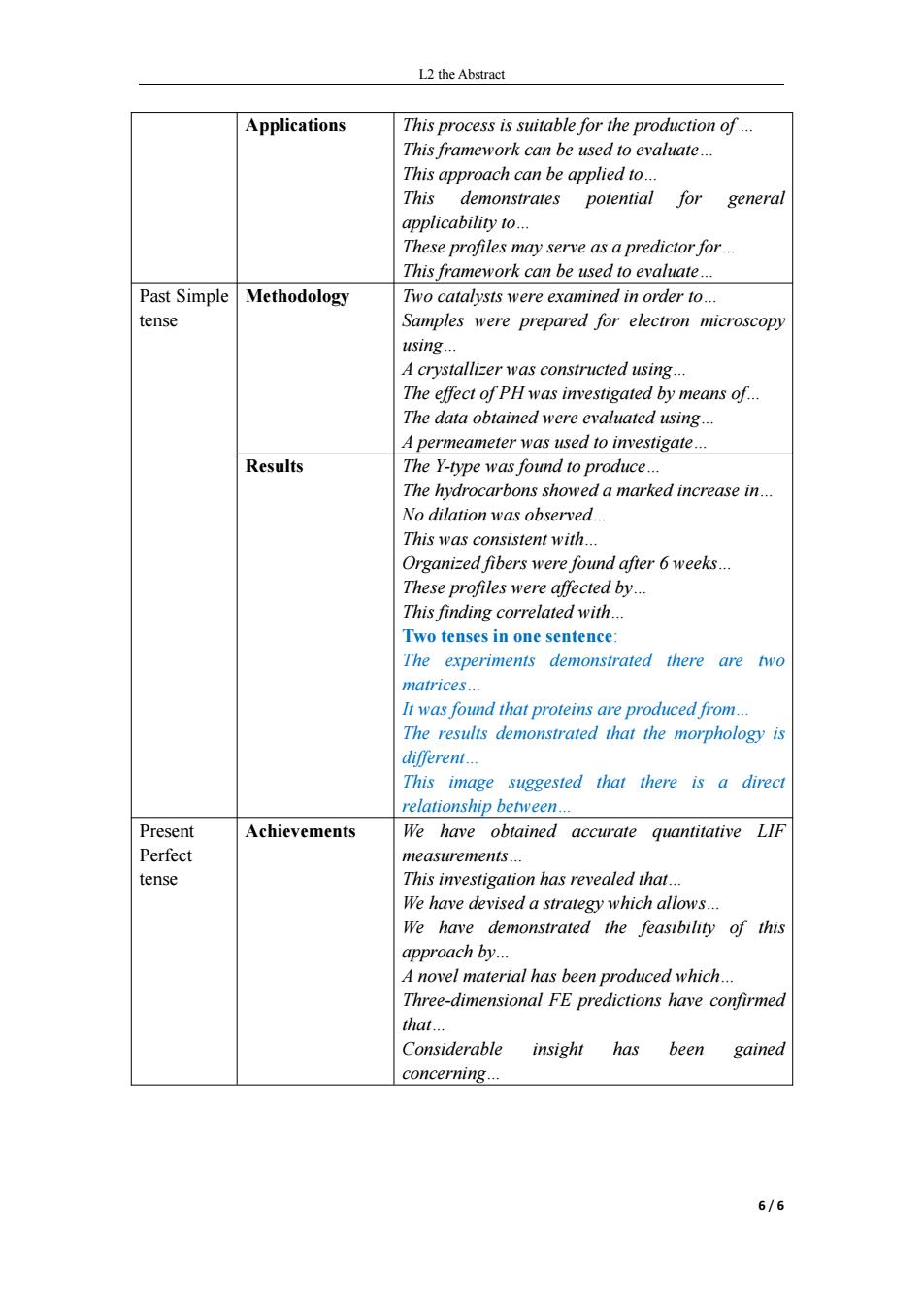
L2 the Abstract Applications This process is suitable for the production of... This framework can be used to evaluate... This approach can be applied to... This demonstrates potential for general applicability to... These profiles may serve as a predictor for... This framework can be used to evaluate... Past Simple Methodology Two catalysts were examined in order to... tense Samples were prepared for electron microscopy using... A crystallizer was constructed using... The effect of PH was investigated by means of.. The data obtained were evaluated using... A permeameter was used to investigate... Results The Y-type was found to produce... The hydrocarbons showed a marked increase in... No dilation was observed... This was consistent with... Organized fibers were found after 6 weeks... These profiles were affected by... This finding correlated with... Two tenses in one sentence: The experiments demonstrated there are two matrices... It was found that proteins are produced from... The results demonstrated that the morphology is different... This image suggested that there is a direct relationship between... Present Achievements We have obtained accurate quantitative LIF Perfect measurements... tense This investigation has revealed that... We have devised a strategy which allows... We have demonstrated the feasibility of this approach by... A novel material has been produced which.. Three-dimensional FE predictions have confirmed that... Considerable insight has been gained concerning... 6/6
L2 the Abstract 6 / 6 Applications This process is suitable for the production of … This framework can be used to evaluate… This approach can be applied to… This demonstrates potential for general applicability to… These profiles may serve as a predictor for… This framework can be used to evaluate… Past Simple tense Methodology Two catalysts were examined in order to… Samples were prepared for electron microscopy using… A crystallizer was constructed using… The ef ect of PH was investigated by means of… The data obtained were evaluated using… A permeameter was used to investigate… Results The Y-type was found to produce… The hydrocarbons showed a marked increase in… No dilation was observed… This was consistent with… Organized fibers were found after 6 weeks… These profiles were af ected by… This finding correlated with… Two tenses in one sentence: The experiments demonstrated there are two matrices… It was found that proteins are produced from… The results demonstrated that the morphology is dif erent… This image suggested that there is a direct relationship between… Present Perfect tense Achievements We have obtained accurate quantitative LIF measurements… This investigation has revealed that… We have devised a strategy which allows… We have demonstrated the feasibility of this approach by… A novel material has been produced which… Three-dimensional FE predictions have confirmed that… Considerable insight has been gained concerning…